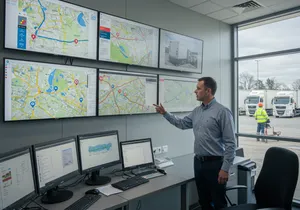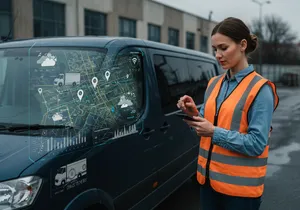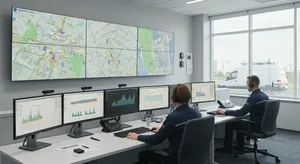Critical Tracking Components
- GPS location monitoring
- Vehicle diagnostics
- Driver performance metrics
- Route optimization tools
- Maintenance scheduling
This page contains GPS tracking information. Use the table of contents to jump to specific sections. FAQ sections can be expanded using Enter or Space keys.
Commercial vehicle tracking solutions transform fleet operations through data-driven insights and real-time monitoring system. Organizations gain precise control over vehicle movements, driver behavior, and operational efficiency through GPS-enabled tracking systems.
Commercial vehicle tracking systems incorporate GPS technology, telematics, and data analytics to monitor fleet operations. The fundamental components include real-time location tracking, vehicle diagnostics, and driver behavior monitoring.

Commercial vehicle tracking provides essential fleet management capabilities. Monitor vehicle locations, driver behavior, and route efficiency with GPS technology.

Commercial vehicle tracking includes route optimization, predictive maintenance, and geofencing capabilities. These features reduce operational costs and improve efficiency.

Commercial vehicle tracking provides 24/7 fleet monitoring with instant alerts. Monitor vehicle locations, speeds, and operational status in real-time.

Commercial vehicle tracking analyzes operations to identify cost savings and efficiency improvements. Optimize routes, vehicle utilization, and driver performance.

Commercial vehicle tracking is a GPS-enabled system that incorporates telematics and data analytics to monitor fleet operations, providing real-time location tracking, vehicle diagnostics, and driver behavior monitoring for businesses.
Commercial vehicle tracking works by installing GPS tracking devices in vehicles that transmit location data and vehicle diagnostics to central management platforms, allowing fleet managers to monitor operations through web-based dashboards or mobile applications.
Core features include real-time vehicle location tracking with GPS coordinates updated every 30 seconds, comprehensive route history and analysis, and driver behavior monitoring for speeding, harsh braking, and idling patterns.
Advanced features include route optimization that analyzes traffic patterns and customer schedules, predictive maintenance alerts to prevent breakdowns, and geofencing technology that creates virtual boundaries around customer sites or service areas.
Real-time monitoring provides 24/7 fleet oversight with live dashboards showing vehicle locations and speeds updated every 30 seconds, instant alert systems for speeding violations or unauthorized use, and emergency response features with panic buttons.
Fleet optimization features analyze operations to create efficient routes considering traffic and customer time windows, provide vehicle utilization analysis to optimize fleet size, and offer driver performance optimization to improve efficiency and safety.
Commercial vehicle tracking helps maintain DOT compliance by automatically tracking driving hours and warning before violations occur, monitors safety behaviors like speeding and harsh braking in real-time, and tracks maintenance compliance with mileage and engine hour monitoring.
Analytics capabilities include comprehensive business reports showing trends and opportunities, detailed cost analysis breaking down expenses by vehicle or driver, and performance benchmarking to compare driver performance and vehicle efficiency across the fleet.
Commercial vehicle tracking integrates with most dispatch software, accounting systems, and customer management tools, provides mobile applications with the same functionality as desktop platforms, and offers API access for custom integrations and automated workflows.
Implementation involves installation taking 15-25 minutes per vehicle with zero downtime, hands-on training for teams on system usage and report reading, and comprehensive support availability for ongoing questions and optimization.
Most companies see commercial vehicle tracking pay for itself within 3-6 months through fuel savings, reduced insurance premiums, improved productivity, and prevented theft, with typical 13-vehicle fleets saving $19,000-$36,000 annually once optimized.
Commercial vehicle tracking provides GPS accuracy within 3-5 meters under normal conditions, with location updates every 30 seconds and comprehensive vehicle diagnostics for precise fleet monitoring and management.
Yes, commercial vehicle tracking reduces fuel costs by 18-28% through route optimization, driver behavior coaching, and idle time reduction, with some companies saving thousands annually in fuel expenses alone.
Commercial vehicle tracking works with cars, trucks, vans, trailers, and heavy equipment, with hardware options designed for different vehicle types and power systems to accommodate diverse fleet compositions.
Commercial vehicle tracking improves driver safety by monitoring speeding, harsh braking, and reckless driving behaviors in real-time, providing coaching opportunities that typically reduce accident rates by 39-49% within the first year.
Commercial vehicle tracking provides predictive maintenance alerts based on mileage and engine hours, helping prevent emergency repairs that cost 69% more than scheduled maintenance and keeping vehicles legal and operational.
Geofencing creates virtual boundaries around customer sites, service areas, or restricted zones, with commercial vehicle tracking sending instant alerts when vehicles enter or exit designated areas for improved security and accountability.
Yes, commercial vehicle tracking improves customer service by providing accurate arrival times, enabling proactive communication about delays, and maintaining detailed service records for better customer relationship management and billing accuracy.
Commercial vehicle tracking provides mobile applications with full functionality including fleet monitoring, driver communication, job status updates, and report access, allowing fleet management from anywhere with internet connectivity.
Commercial vehicle tracking uses encrypted data transmission, secure cloud storage, user authentication protocols, and regular security updates to protect sensitive fleet information and ensure compliance with data protection regulations.
Support includes hands-on training for system usage, technical assistance for installation and setup, ongoing customer service for questions and optimization, and regular software updates to maintain system performance and security.